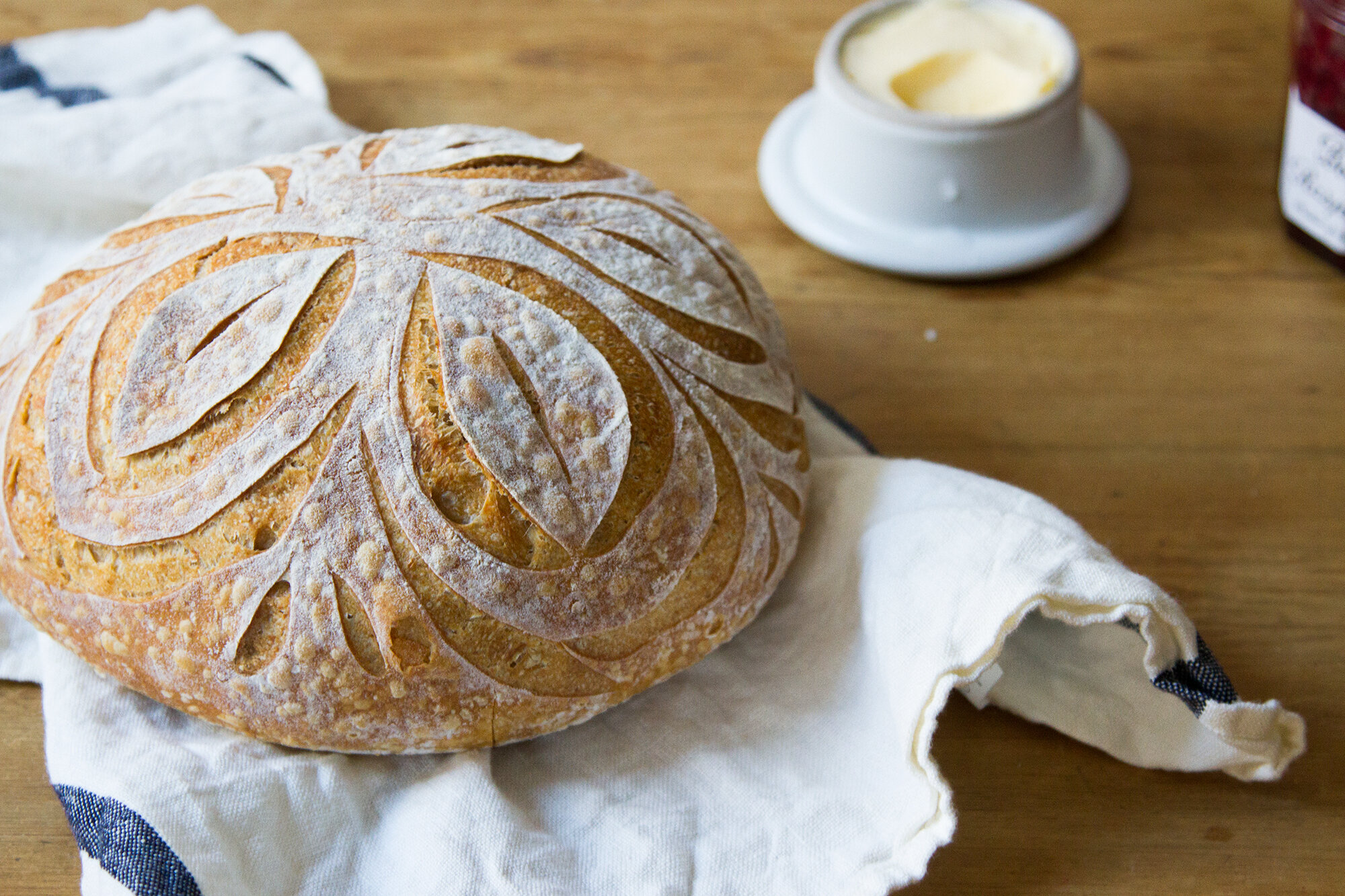
The very best thing about James’s sourdough habit is that it’s his. It doesn’t involve me apart from the fact that most every week I can rely on there being a big old loaf of sourdough bread to plow through. (Elegant, I know.)
Suffice to say, this isn’t a how-to, or a recipe, or a guide to becoming a sourdough master. I’m certainly not qualified to offer any of those things and despite his very regular habit, James doesn’t fancy himself enough of an expert to pen a full guest post on the subject of sourdough either. Still, since I’m not sure that I can bear to send another “sorry, not really my thing” email to hopeful readers, here are a few answers to frequent questions, a few helpful pointers, and a few resources for folks looking to embark on their own sourdough journey.
Godspeed. (All I can really tell you is it will be tasty.)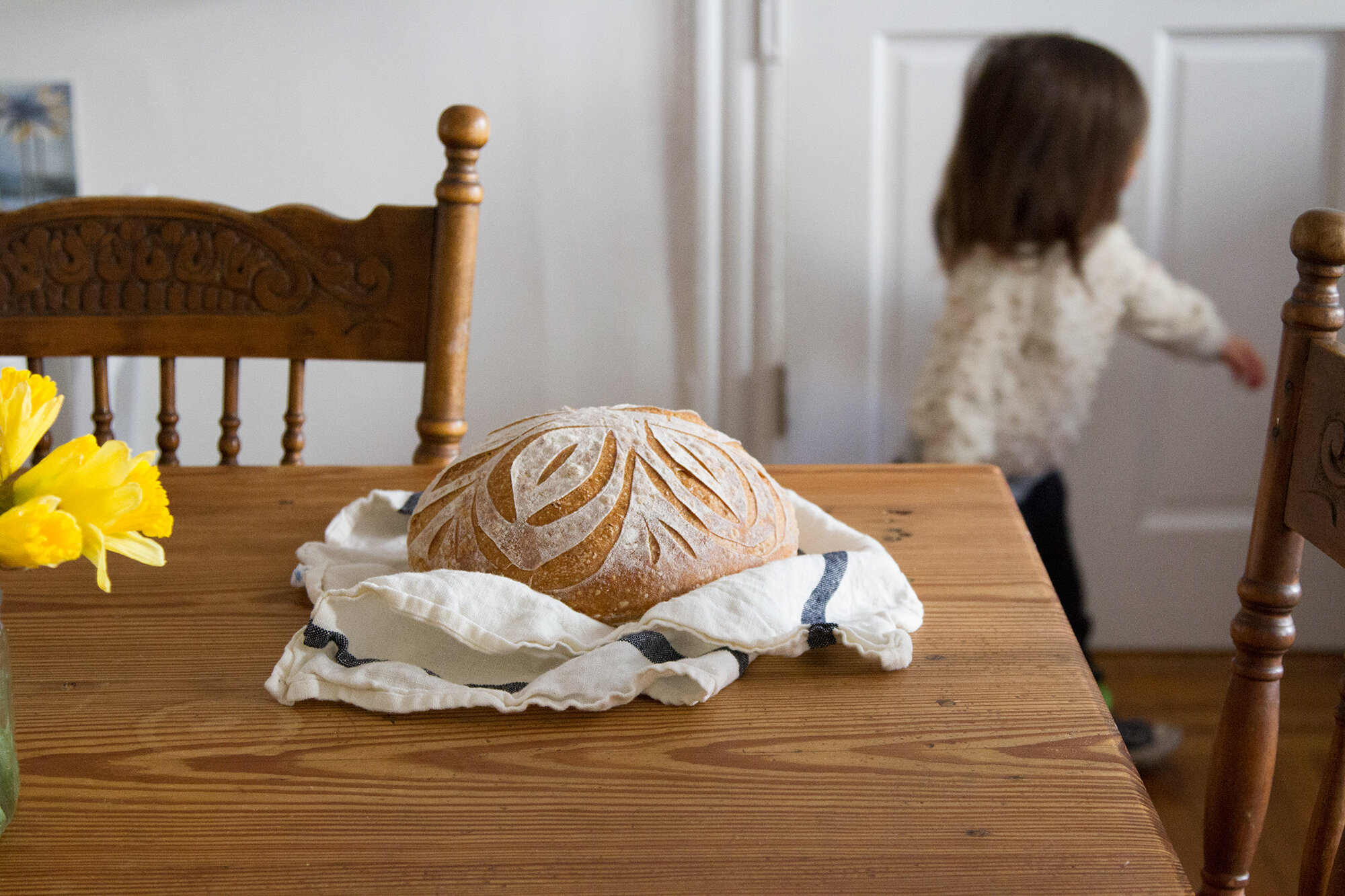
Sourdough FAQs:
What method do you use?
James taught himself to make sourdough bread using Chad Robertson’s Basic Country Bread recipe. It’s been pretty darn reliable for him (and many of other Tartine devotees). The full method, in all its multi-page glory, can be found in Robertson’s 2010 cookbook, Tartine Bread; the New York Times reprinted a version here. Happy reading.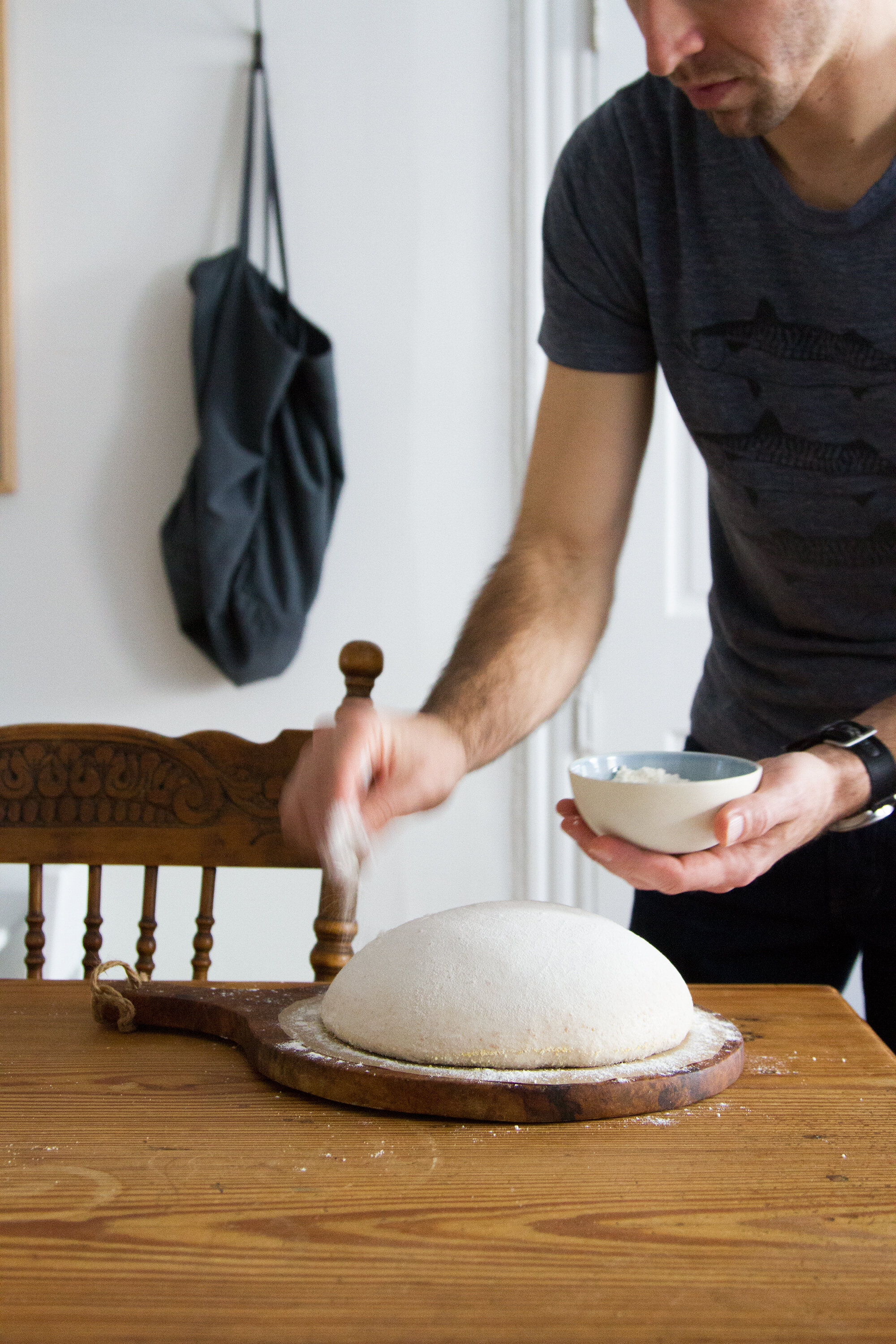
Where’d you get your starter?
James got his starter from a sourdough pancake workshop that we took at Best Made Co. in the spring of 2014 before Faye was born. The class was taught by sourdough pancake extraordinaire, Ron Silver of Bubby’s, and participants all went home with a little mason jar full of starter. James has been keeping his alive ever since. If you don’t have a local restauranteur or friend willing to share some of their starter with you, never fear, you can make it yourself. (Full how-to in the Tartine cookbook referenced above!)
Is it a lot if work?
My answer: Yes! His answer: No, not really! (Shoulder shrug.) The basic work behind sourdough is that you have to “feed it.” In the least nerdy terms possible, this essentially means that you need to regularly maintain your starter with fresh flour and water so that the good microbes keep growing and harmful bacteria and fungi are kept away. Since James makes bread most weeks, he keeps up a regular weekly schedule; feeding the starter in the morning of the day he plans to make dough. If we’re traveling or lazy, James just makes sure to feed the starter at least once a month.
Doesn’t feeding it create a lot of waste?
If you make a habit of baking regularly, nope! But if you are finding yourself with a lot of excess after feeding your starter, King Arthur Flour has lots of good ideas for how to use it!
What kind of flour do you use?
James uses all-purpose unbleached flour; mostly King Arthur’s Organic All-Purpose and whole wheat all-purpose flour from Farmer Ground Flour.
How do you make it so pretty?
Well, far be it for me to judge, but James’s breads haven’t always been so pretty. In the beginning they were kinda wonky and flat-ish. Now they’re awesome. Practice makes less wonky! James loves to get real nerdy and snoop around Instagram getting sourdough inspiration. Some of his favorites feeds are from @breadbakersguild, @maurizio, @katesbread, @sarah_c_owens, @ca_mia_breadlab, and @bakerhands.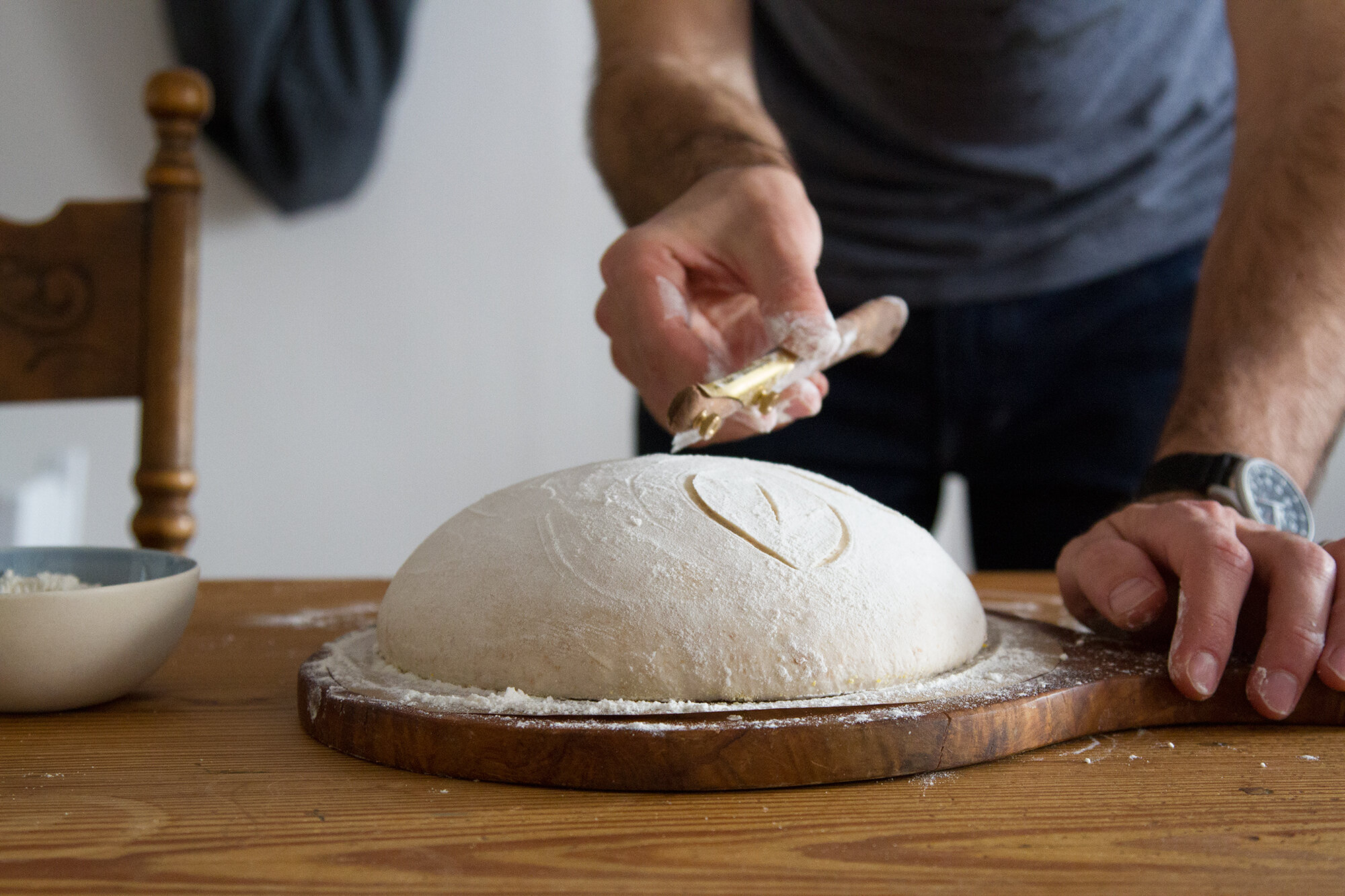
Do you need any special tools?
A few bread-making specific and non-specific tools go a long way.
James uses:
+ A walnut bread lame for scoring.
+ A walnut dough scraper for shaping.
+ A banneton and liner for dough resting.
+ A digital scale for measuring. (James has also endeavored to weigh both ALL of our children using our scale. Results for human children unreliable, results for dry goods, great.)
+ A bread pan for baking in.
2020 Update: Challenger Bakeware gave James the opportunity to test-drive his sourdough in their Challenger Bread Pan earlier this year. It’s enabled him to bake larger loaves that don’t get smooshed in our dutch oven and it’s now the pan he uses exclusively to bake in. I’ve updated links for the other essentials James uses to direct to Challenger where RMTL might earn a small commission for any products sold.
(2017: Not for bread, only, James bakes his bread in our oven inside our enameled dutch oven. (Persnickety cohabitor warning: Unless you’re an exceptionally diligent scrubber, putting your enameled cast iron into the oven week after week at such high heat will mean it inevitably gets some baked on brown drips and spots. A soak in baking soda and lemon goes a really long way toward cleaning it up, but if you have the room for it, you might consider getting a plain old cast iron dutch oven or (even better) a double cooker for home bread-baking.)
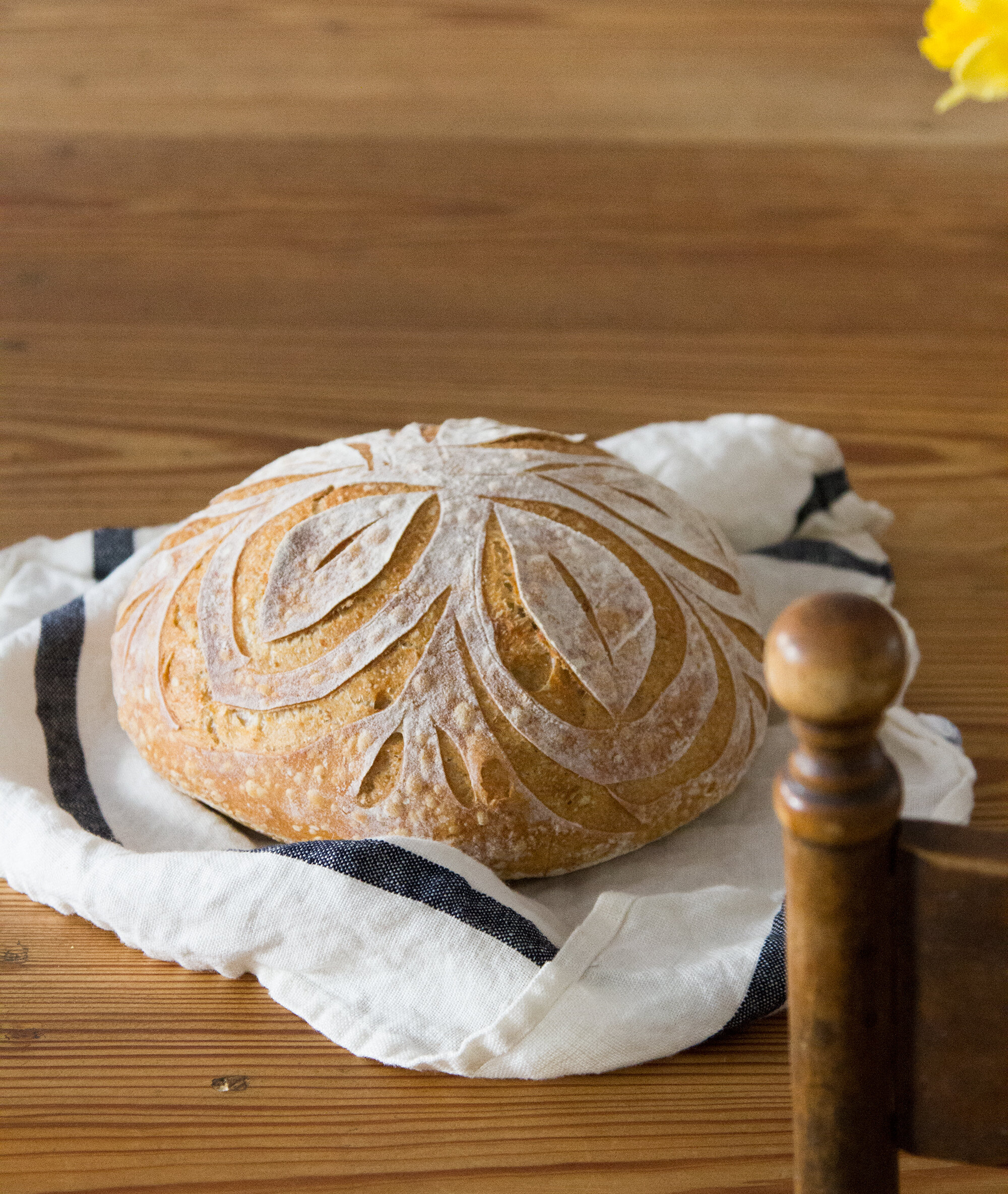
Tell me about the pizza!
It’s so delicious!!! James uses Chad Robertson’s method from the Tartine Bread cookbook here, too. It’s so much better than other homemade pizza we’ve endeavored to bake and not just because I’m not the one making it.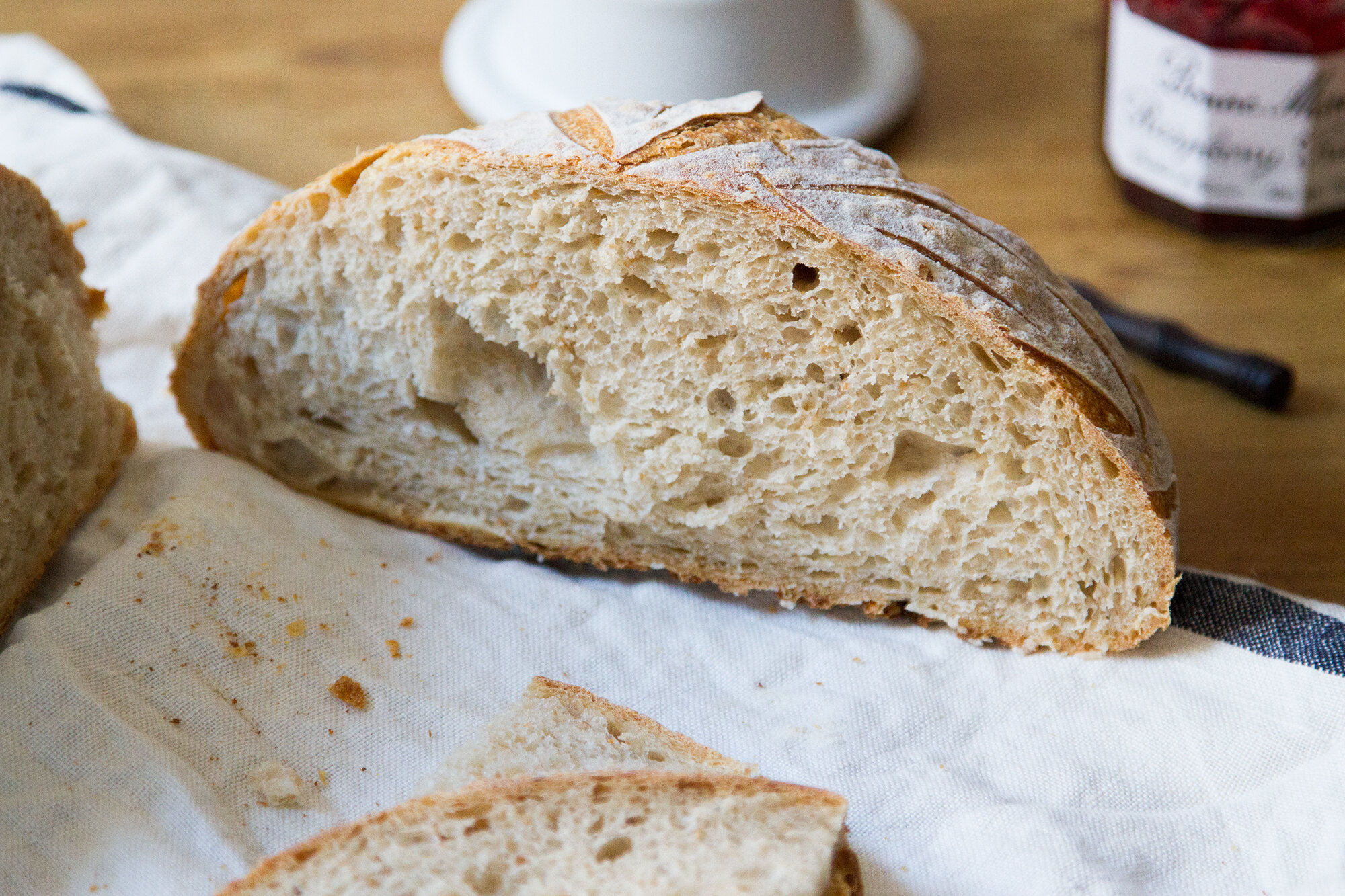
A few other tips for serious sourdough nerds:
+ After James shapes his dough, he finds he gets more flavorful loaves by putting it into the fridge for an extended final rise (12-24 hours).
+ James uses parchment paper to get his scored loaf into the hot dutch oven without smooshing the loaf or burning his hands.
+ If you start a regular bread-baking habit, expect some burns. James coerced me into getting him a pair of heavy-duty oven mitts. They take up all our remaining cabinet space, but at least his hands aren’t getting burned weekly.
+ Many moons ago, James and I had the chance to taste a loaf of Sarah Owens’ rustic sourdough bread. Her newish book Sourdough is a beautiful guide to getting fancy with sourdough.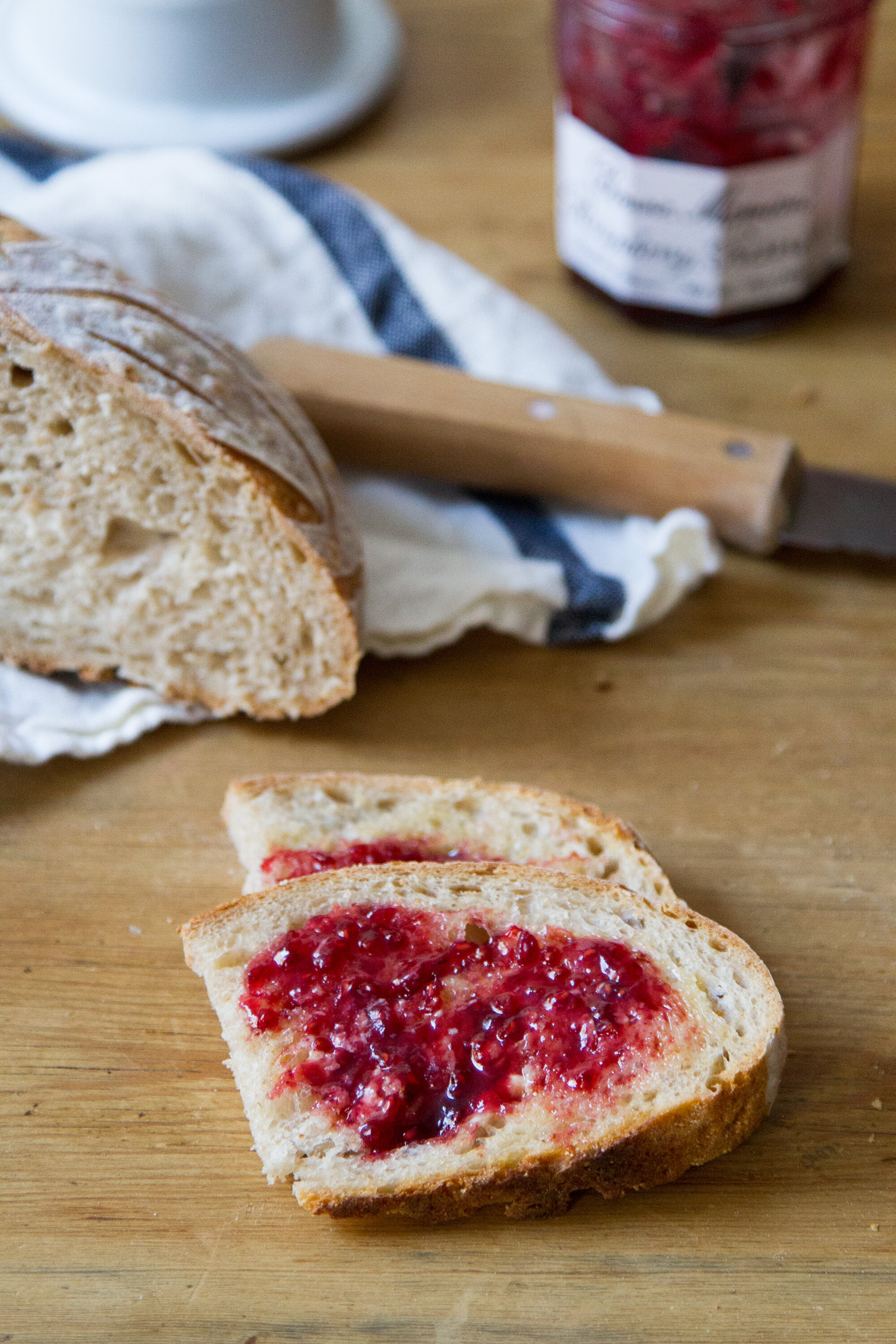
What about you guys? Seasoned sourdough experts out there? Newbies? Feel free to geek out in the comments. I’ll be watching from the sidelines.


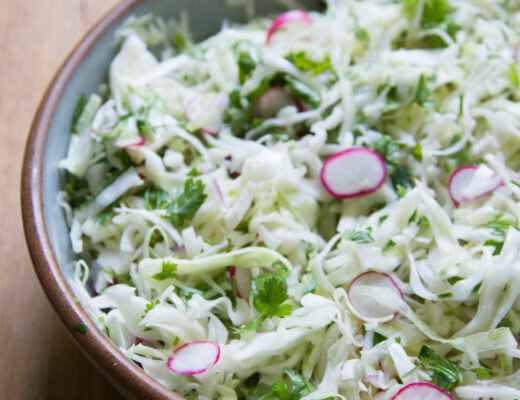
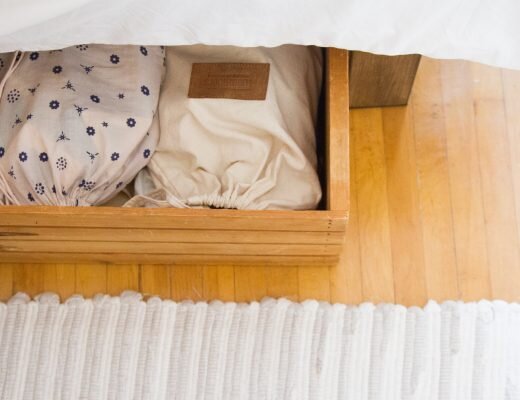
65 Comments
Hey Erin! Love this post! My husband and I have tried to keep a starter going a couple times now but inevitably it grows so big (for lack of actual bread making) that I get tired of having a massive Tupperware sitting around and call the whole thing off! What do you guys keep your starter in? And is it left out on the counter or do you keep it in the fridge and just feed it a little less? Thanks!
James keeps his starter in a large Weck jar and definitely keeps it in the fridge! He feeds it before he bakes bread each week, or every few weeks if he doesn’t have time to bake!
Hi Alison– according to tartine method you’re discarding 80% of your starter before each feeding. This is the trick to keep it from growing big. Then, when you are ready to bake you’re discarding all but 1 tbsp of starter, which you use to make the leaven. You will not end up using all of your leaven to make the dough, so the leftover leaven becomes your starter for the next time. I’ve found that a close reading of the book is super helpful.
Fellow “PTSB” here! (that’s “Partner To Sourdough Baker”:)
In the past year, my husband has fallen down the sourdough black hole, and while I totally support it and benefit from it, holy smokes is it a life-style! He brings it with us when we travel, because why not bust out a loaf in a new oven?! We have lengthy (somewhat one-sided) conversations regarding how long a loaf had “rested” prior to baking, was it scored deep enough, what is happening with the “critters” in the starter, etc. I joke but I do feel so lucky to have fresh bread weekly, not to mention a constant supply of toast, bread crumbs, and croutons. It truly is an art form too – no 2 loaves come out the same! (at least in our house…) My husband uses an old cast iron dutch oven and stores his starter in a recycled Bonne Maman jar.
Great post – thank you for sharing – I’m really intrigued by the lame. Is it really that different from say a serrated knife?
Ha! Solidarity! As for the lame, I imagine it’s mostly different from a serrated knife because the blade isn’t serrated, it’s just a straight razor. (So in that sense, not different than a straight razor you might fit into a chopstick a la Chad Robertson.) Still, made for an awfully pretty birthday gift for this “partner to sourdough baker” to offer all the same!
Thank you, ERin! It is actually my baker’s birthday on Wednesday so I’m gonna go get him a lame and also the Sarah Owens book – that looks excellent. This post was very well-timed for me. 🙂
Also partner to sourdough baker here, and I gifted her Sarah Owens’ book last fall after stumbling upon it at my favorite small bookstore — she loves baking from it and nerding out on the different starter method (something about hydration levels that is distinct from Tartine) and I love the diversity of grains & goods coming from our oven. Plus, the photos are gorgeous. I’m intrigued by the lame 🙂
Thanks for the tip on the Sarah Owens book. My PTSB loved it. My whole family (except him!) got taken down by this virus this weekend. All are on the mend now. But he spent the whole weekend reading and baking from this book. Now if only the rest of us had appetites and wanted to actually eat any bread…
Haha! I am so comforted to know I am not alone with the husband-who-loves-his-starter and has one sided conversations about bread! We are a lucky house to have delicious bread. Thanks for the post and the tips!
I kept trying to get a started, well, started and it kept dying on me. So sad. The one time I attempted sd rolls, they were not very good. Perhaps I will try again in the fall (since our house gets WAYTOOHOT in summer to run the oven).
ah, yes! here, too! we have to go on a bread hiatus in the summer (but we still eat plenty of sourdough pancakes!).
Thanks for this post! I’ve often thought I’d love to start making sourdough at home, but feel intimidated by the process. Those loaves that James makes are beautiful! I regularly make a version of the fast no-knead recipe that was published in the Times a few years ago and that I’ve tweaked in order to swap white whole wheat flour for half of the bread flour. I love making bread at home — it’s so delicious and so much less expensive!
I bought my fiance the Bread Bible for Christmas this year, and he’s made bread almost weekly since then. Like you, I can’t lend much to a bread conversation except to say that I have zero complaints about his newfound love of baking. I’ll be forwarding this to him — especially the extra tools part. Thanks!
I’m so appreciative of this post!! I made my own sourdough starter this past September after ogling your Instagrams (and then proceeding to follow James’ account as well). My starter is thriving , though my breads are far from beautiful. Hoping to invest in some books and tools down the road, but these links will be very helpful in the meantime. Thank you 🙂
If people just want to make bread – I highly recommend the book Artisan Bread in 5 Minutes a day. There might be a sourdough recipe in there (I just gave the book away via my local Buy Nothing chapter), but I’m not sure. B/c of that book – I haven’t bought bread or pizza dough since 2010. Ingredients are salt, water, flour and yeast. Really easy! Bread and pizza dough freezes really well too – I made and froze six loaves in anticipation of my daughter’s arrival last fall 🙂
Hi Erin! Love your blog and what funny timing…I made my very first sourdough starter last night! Quite cosmic timing to wake up and see your insta post. I’ll have to take a peek at these books too. Thank you (and James–your bread is beautiful!) for sharing! Fingers crossed my sourdough adventures are as successful as this! xo
Ugh. I was about to give up on my sourdough starter. We just moved to Portland, Oregon and so my east coast starter was left with a friend. But then, I also just invested in my own copy of the Tartine book, which I had been borrowing from my local library back in Massachusetts. And, now, this post! So, I’m going to try leaving it in a warmer spot. I seem to remember using a heating pad the first time I made my own starter.
Also, James, why can’t I keep my lame from catching on the dough? I’m not even trying to make a design, just a few clean cuts. Please advise!
I don’t know about the lame, but I’ve always had good luck with just a straight edge razor. Best of luck!
Yes: it *is* a straight edge razor in wooden handle which helps with control (and might help with getting those pretty cuts:)
Judith! James swears by doing the final rise in the fridge so that by the time you’re doing your scoring, you’re working with cold dough and the lame slices cleanly through without catching!
Thank you James and Erin for that excellent tip. I have a feeling that cold final rise also adds flavor. I’ll let you know how it goes, once I get the starter going.
Yes, exactly what James thinks!
What an exceptionally beautiful loaf of bread–I bought Tartine and was immediately overwhelmed by sourdough, so am impressed with James’ shrugging it all off! As a lazier bread-maker, I went with Jim Lahey’s no-knead technique instead.
I had a summer of breadmaking when I first got the Tartine book as a gift. I’m heartened to know James’s bread wasn’t always quite that gorgeous. 😉 Mine were delicious but flat. I love the cookbook – I read a lot of cookbooks and frankly am not usually interested in baking but it is so inspiring. Chad is an artist, and I’d say James is too!
The thing did me in was the clean-up – do you guys have any tips there? My sink and butcher block were always covered in sticky flour, it gummed up my sponges and/or towels and if I missed anything it turned into cement. It was such a pain!
No comment. (Jk; it is kinda messy. But he who makes the mess cleans the mess!)
I find that a dough scraper does wonders with cleanup, as well as handling sticky dough. I hear you on the towels though – just destroys them. The solution to a lot of my troubles was getting a brotform, which is just invaluable.
Oh, that’s another tool of James’s: a small plastic dough scraper. Brotform = banneton, FYI!
First of all. Thank you for the beautiful helpful post. LONG time coming! Question: Does James bake the bread with the parchment paper? What are James’ thoughts on such high heat and parchment paper? Does he use a special kind?
I use one of the silicon baking mats when I make bread – works well for me and less wasteful than parchment. But – the parchment is fine at the high temps.
Awesome! I did a little research into silicone mats and found some great round ones, but none that were rated to go past ~450-480 degrees. Maybe not a real concern?
I think my parchment paper box says no higher than 425 and in my experience I’ve used it in 450/475 and the paper burnt. I did not mind that at the time (actually had great bread results!), but a baking friend told me she’d be concerned that “overbaking” parchment might result in release of chemicals. Some Googling indicates others would be too. Just wondering if this is something that concerned James and whether he looked into it. Erin I presume from your answer that he bakes the bread sitting on the parchment paper.
Interesting! Yes: Correct presumption! I was concerned about the heat limit on the silicone sheets (all those that I’ve found say you can heat them up to ~450 or ~480), but honestly never looked to see what the parchment paper said! It doesn’t burn when James uses it, but it does crisp up a bit! Not sure which would be the better choice from a health perspective.
I love this post!! I have dabbled in sourdough myself and it’s such an interesting little hobby, that results in the yummiest bread. I used a method where I “captured” wild yeast, since I already baked a lot of bread, lots of yeasts just floating around (how cool! & who knew?!). My loaves never looked so fancy though! This inspires me to get another batch going…My husband would be so happy. My only failing is, inevitably, I get distracted and the starter goes bad 🙁 But you can always just try again.
I’m curious what other “homemade” adventures you’ve had Erin, and other readers? I’ve made yogurt, nut milks, ice cream, dehydrated and canned foods…it all makes you feel so accomplished 🙂
perfect timing! timehop tells me that one year ago today, i baked my first loaf of sourdough. i also use tartine’s method, with a tweak. i made my own starter, and it kept dying on me when i tried tartine’s half whole wheat and half AP flour recipe. so i switched to using rye for my starter and leaven, and half-n-half for the bread. it works great! i used farmer ground flour rye. i still giggle gleefully when i pull a loaf out of the oven. it feels like magic every time.
What a beautiful and tasty habit! My only question is a bit awkward. How do you stay in such a fit state eating bread? No, really, would love a post about that.
I’m afraid you won’t find much of a fitness expert here.
I have been eyeing your husbands’ sourdough on instagram for a while. I started baking with Chad Robertson’s method last fall and LOVE it. I love the ritual of baking it every Sunday. I love the practice I get week after week as I learn new things and perfect the method a little better each time. I love how much of the recipe relies on smell, taste, touch, sight even sound. For those who are trying to get started, I’d highly recommend Chad Robertson’s book. Read it thoroughly and be patient with yourself. Many loaves will feel like failures (although enough butter and a toaster can make those perfectly edible) and even after you get good for a while, you’ll have some bad loaves, but as you practice, you get better and better. It is one of the most rewarding things I have ever done. And it has also ruined me for store-bought bread.
Hi Erin and James! It just so happens that I am baking bread at this moment! Not sourdough, however, but a delicious, basic hearth bread from The Bread Bible. (We had this book checked out from our local Library for weeks and weeks, and we finally decided to add it to our cookbook collection!) I’m a newbie at baking bread, but I am no longer intimidated by yeast and the multiple rises! I will definitely look into the books and recipes you suggest! Happy Spring Equinox!
Yes! Total newbie here. And thanks for the post. I can imagine all the emails lol.
Happy First Day of Spring btw.
🙂
This makes me so excited to take my sourdough class on Saturday!
Yay!
Just wanted to say : get some really good jam to schmear on that bread! It looked so tempting till I saw the supermarket jam
Foiled again by pedestrian jam!
Ha!
And forgo the useful, aesthetically pleasing BM jar? Tough call
Oh, it looks so good that I almost want to try it myself! Almost. Like you, I prefer for someone to make it for me. Now I just need to find a baker…
The book I finally successfully learned to make sourdough from is Josey Baker Bread. I recommend it to all aspiring sourdough bakers who find percentages and hydration and such a bit too overwhelming.
I, too, have been making sourdough from Tartine’s book for a few months, with delicious results! One question though… when you put the starter in the fridge to leave for a long vacation, have you ever returned to find spots of mold? Recently, I left my starter in the fridge without feeding and a couple spots of mold had developed..
Thankfully I was able to rescue enough starter to restore it to normal, after a few regular feedings. I’m leaving on vacation again soon and don’t want this to happen! Any Advice? Thank you!
James has never gotten moldy starter, but he did recommend this page for troubleshooting! Good luck! http://www.culturesforhealth.com/learn/sourdough/troubleshooting-sourdough-starter/
During vacation time, I put my starter in the freezer for a few weeks. Before I started using it again, I just let it sit out until it reached ‘sort of’ room temperature and then I re-fed it a couple of days and then used it. Worked fine!
Sounds amazing! I love King Arthur flour recipes.
This bread looks so good. Especially with that jam. This is making me want to get cracking on my own starter asap! I’ve been considering since reading Cooked by Michael Pollan but haven’t yet, perhaps this post is my push!
Thank you!
My great-aunt Trellibelle was the keeper of the sourdough starter in our family and when she died, no one knew to care for it. It got tossed… it must have been a hundred years old as she got it from her grandmother. Ever since, I’ve been searching for that flavor of her bread and never have found it.
I think I’m ready to create my own.
Love this post – thanks! Do you or James have a bread knife reccomendation?
I tried making sourdough ten years ago…it turned out too sour and I haven’t tried since (though I have milk & honey sandwich bread recipe that been serving nicely). I’d love to try again and the beautiful photos you post on Instagram of James’ creations are always inspiring! Thank you for the tips! Do you have a preferred container for keeping baked bread fresh?
Hi Erin, was just wondering what size Le creuset you have to make such a nice size loaf? I’m getting a second hand 4.5l one but can’t tell if it’s big enough
Ours is the #28, so 6.7 liters/7.25 quarts! Not postive if 4.5 liters would be big enough!
Ours is the #28, so 6.7 liters/7.25 quarts! Not positive if 4.5 liters would be big enough!
What a wonderfully informative article (info in comments is terrific too). I’m a recent 100% sourdough bread convert (it’s all we eat now – so good) and have been itching to make my own. Thanks!
Hi Erin, do you have a source for your round wooden pizza peel/cutting board? Its so rustic and beautiful. And doesn’t appear too large!!
Hi Heidi! It’s an olive wood cutting board that James and I bought at a roadside market in France ten years ago this spring!
What a wonderful post. Please do ask him for a guest post if he wants to talk about sourdough. You instagram photos of his bakes make me hungry !
Erin, would you mind sharing which heavy duty oven mitts you decided on? I’m in the market for some new ones and I am always so pleased with your recommendations.
-Virginia
Hi there! We originally had a large leather pair that James had really wanted but that honestly ended up being quite cumbersome in practice. Last Christmas I bought James a pair of silicone baking mitts from Challenger Breadware (that’s an affiliate link!) that have been a big improvement!
Comments are moderated.